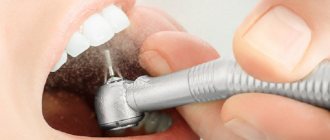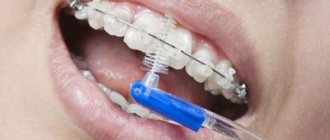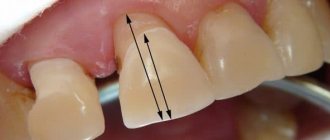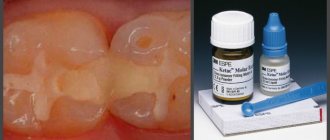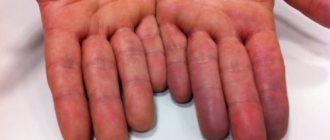How to understand that a filling has fallen out
How can you tell if a filling has fallen out of a tooth? The simplest thing is that if it fell into the sink after rinsing your mouth or broke off while eating, a specific sound or discomfort will indicate the loss. You can also run your tongue over the causative tooth (it will come across sharp edges or a formed “hole”). You can also look in the mirror with your mouth wide open and see a hole in the crown. If the problem is not identified by any of the methods described, then pay attention to your sensations - is there a feeling of sore throat or pain? If the answer is positive, it is quite possible to assume that a small filling has fallen out or part of a large one has broken off.
A filling fell out, how long can you walk painlessly without it? Possible consequences
The situation when filling material falls out of its intended place is, unfortunately, not uncommon. Often the culprit in the incident is the person himself. Men and women wonder whether it is possible to leave everything as is and not visit the dentist for treatment? The answer to this question is clear - no. If a hole has formed in a tooth, it is not a matter of aesthetics. Loss of the filling leads to the development of dangerous complications and complete destruction of the affected unit.
Why does hair loss occur?
The reasons for fillings falling out of teeth are quite diverse - it could be a dental error during treatment or filling, the patient’s health and metabolic rate, hormonal changes, as well as a person’s failure to follow the rules for caring for the filling. Let us dwell on the reasons for fillings falling out of teeth in more detail.
Poor fixation
If the filling falls out of the tooth very shortly after treatment, this indicates poor-quality fixation of the material in the cavity. This happens in the following cases:
- poor treatment of the cavity before filling: non-compliance with the turning technology (the enamel may break off with a piece of the filling) or incomplete removal of dentin and enamel infected with caries (secondary caries will begin),
- non-compliance with the period of exposure of the antiseptic composition: pockets with harmful microorganisms remain in the cavity, which continue to destroy dental tissue.
- incorrect selection of adhesive material: applied to bond the filling composition to the tooth,
- poor-quality drying of the cavity before filling: particles of water and saliva neutralize the adhesive effect, and also create microscopic voids near the walls of the cavity - as a result, loss occurs.
Fixation can be broken even with very large defects. For example, when the carious cavity is very large, i.e. the dentist had to drill out tissue from both the lateral and chewing surfaces. Here the filling will be loaded both from above and from the side, and over time it may become loose and fall out.
Problems with filling material
When treatment is carried out by a competent specialist who has a sufficient selection of materials for each case, the risk of loss is minimal. However, there is always the possibility of ending up with a non-professional (who, due to non-compliance with the technology, may incorrectly install even a high-quality composition), or becoming the “lucky” owner of expired or low-quality filling material.
Good to know! Errors occur when diluting the filling mixture (temporary or permanent); they increase the risk of depressurization of the cavity. A violation of the technology for installing a light-curing composite or short exposure to a blue polymerization lamp does not allow the composition to harden normally.
There are cases of loss due to the introduction of excessive or, on the contrary, too little amount of filling composition. If the filling is large and protrudes from the bite, then the antagonist teeth will regularly apply excessive pressure during chewing, and gradually the material will peel off and fall out.
Incorrect diagnosis and treatment
Before treatment, a diagnosis should be carried out to accurately determine the disease - caries, pulpitis or periodontitis. Therefore, very often professionals use x-ray diagnostics and electrical odontometry. If a pathological focus remains in the tooth (in the pulp, root canals or under them), then serous fluid or pus will gradually accumulate here, which will provoke loss.
Loss caused by patients
After treatment, the patient needs to take care of the filled tooth, but some ignore the recommendations and then go to the dentist again. The filling can fall out due to chewing gum, taffy or toffee - gradual or sudden detachment occurs. Very hard foods, nuts, and candies can also cause hair loss.
What to do if a filling falls out and your tooth hurts
A filling falling out of a tooth can also often be accompanied by pain. If you find that after “losing” a filling, your tooth is bleeding, or you simply experience unpleasant or acute pain, and there is no opportunity to see a doctor, you can numb the aching tooth yourself at home.
One of the main ways is painkillers! Yes Yes! Exactly! However, the tablet should not be chewed, swallowed, or taken with water as usual. The only and surest way is to hold an analgin tablet (for example) near a sore tooth until it completely dissolves.
By breaking down, the soothing properties of the tablet penetrate into the filling cavity, bringing the nerve into a calmer state, soothing and comforting the pain threshold of the tooth surface. And you don’t have to worry about the filling falling out, since a professional dentist can easily and quickly correct this unpleasant situation.
And remember! Do not try to replace a fallen filling under any circumstances, as this may lead to deterioration of the tooth surface.
Loss and replacement of fillings during pregnancy
Pregnant women should think about oral health at the planning stage of motherhood. But even a responsible expectant mother can suddenly be overtaken by caries during pregnancy, since changing hormonal levels affect metabolic processes, and dental tissues become fragile. What to do? It is possible and necessary to treat teeth and put fillings during pregnancy, as well as replace damaged or fallen ones, if necessary.
The only exception is anesthetic injections. Some drugs (with adrenaline and epinephrine) are prohibited from being administered in the first and third trimesters, but can be administered from weeks 14 to 27. But, for example, with articaine, treatment can be carried out in any trimester, of course, if there are compelling indications for it. An injection usually treats pulpitis or deep caries, and early carious processes can be removed without anesthesia at any time.
Loss of fillings in primary dentition
For dental treatment in young children, there are special cements that do not compromise their properties if liquid gets into the cavity during the work. It is quite difficult for a child to sit for a long time with his mouth open, so the materials used are plastic, easy to shape and quickly harden in the oral cavity.
The answer to the question why a filling falls out of a baby tooth is obvious. Not every child will sit calmly in the dentist’s chair and do what the doctor says. Treatment is usually stressful for both children and their parents. Therefore, the doctor must work quickly, otherwise the child will simply close his mouth. It is not surprising that it is sometimes difficult for a dentist to prepare a cavity according to all the rules, as well as securely fix the filling.
Another feature of the treatment of young children is the use of materials that contain as little “chemistry” as possible. Therefore, the adhesion between the filling and the tooth occurs only mechanically, which also does not contribute to its reliable retention in the cavity.
How to help yourself before going to the clinic when your tooth hurts
The cavity that opened after the filling material fell out in the tooth often hurts. What to do in this case? To alleviate the condition and relieve pain, it makes sense to rinse with soothing solutions. The easiest way is to dilute 1 teaspoon of baking soda in warm boiled water and regularly rinse your mouth with this mixture.
It is important to know! You will have to rinse your mouth often - after every meal. After all, it is necessary to remove everything that gets clogged into the open cavity and can serve as a source of inflammation and a breeding ground for microbes.
Avoid chewing food on the affected side to prevent chipping of the rest of the crown. This point is especially relevant when a filling has fallen out of a front tooth - you will have to cut any food into small pieces so as not to bite off anything at all.
If the pain is severe, you can take an analgesic. And don't forget to make an appointment with the dentist soon. You also need to know what kind of composition was installed in the tooth - temporary or permanent. This will help in further actions.
Symptoms
A clear sign that the filling has fallen out is a hole or the appearance of a cavity in the place where it was installed. Its size depends on the degree of tooth damage before treatment. But the following symptoms may also occur:
- Pain. It can be temporary or permanent. Painful sensations most often occur when eating hot or cold foods, as well as from mechanical stress.
- Sensation of sand on teeth. Occurs when a damaged molar continues to decay.
- Sores on the inner surface of the cheeks or lips. They appear as a result of the fact that a chipped tooth begins to touch the mucous membrane, injuring it.
But if a filling falls out, symptoms may not appear. This is due to the fact that during treatment the doctor removed the nerve endings from the oral cavity. But in any case, even if pain does not occur, you should consult a specialist.
What to do if a temporary filling falls out
Patients often complain that a temporary filling has suddenly fallen out. What to do before visiting a doctor? First, again, you need to rinse your mouth well to remove any remaining medication from the cavity. After all, if the seal covering the drug with arsenic falls out, then swallowing such a drug is extremely dangerous for the body.
Helpful information! There is no need to try to remove the remaining paste or filling from the cavity yourself using sharp objects. This can not only damage the thin walls, but also drive the medicine (along with bacteria from the external environment) deep into the tooth.
Common causes of fillings falling out
There are many reasons that lead to a filling falling out, and all of them can be divided into three large groups:
- medical errors;
- errors caused by the patient;
- features of the material used.
Let's take a closer look at each of them.
Iatrogenic errors
Unfortunately, one of the reasons why fillings fall out of teeth is medical error. Non-compliance with the technique of working with materials, lack of time for conscientious work and insufficient competence of the doctor, and sometimes the human factor (fatigue, inattention) can play a role here.
Due to the fault of the doctor, the filling may fall out in the following cases:
- violation of the rules for preparing cavities - in order to reliably retain the filling material in the tooth, it is necessary to follow the basic principles of treating enamel and dentin with boron. This is especially true for caries that affects the dental walls or the cutting edge of the front teeth (classes II and IV according to Black’s classification). When removing necrotic tissue and creating a cavity for filling, the dentist must pay attention to ensuring that the area of the bottom and walls are proportionate. Otherwise, the mechanical adhesion is disrupted, which leads to the loss of the restoration;
- incomplete removal of tissue affected by caries - when, during preparation, the doctor, through inattention or for fear of opening the pulp chamber, leaves altered dentin at the bottom of the cavity, this leads to the fact that an infectious process begins to develop under the filling. Hard tissues are destroyed, so the boundary between the tooth and the filling is broken, as a result of which the restoration begins to loosen and may fall out;
- short time of etching of enamel and dentin - the total etching technique does not lose its relevance to this day, although adhesive systems have been developed that do not require prior carrying out this manipulation. Etching involves applying a concentrated gel based on orthophosphoric acid to the washed and dried surface of the hard tissues of the prepared cavity. This procedure removes the smear layer of dentin, removes excess inorganic matter from the dentin tubules, and also creates roughness on the enamel, which enhances the adhesion between the filling material and the tooth. According to the rules, enamel is etched for 30 to 60 seconds, and dentin is etched for 15 to 30 seconds. If you change the time down, this may negatively affect the quality of the restoration.
- violation of the adhesive protocol - the main purpose of introducing adhesive into the cavity is to create a kind of “sticky” layer that allows the filling to firmly contact hard tissues. The main condition that must be observed is absolute dryness. Even a small ingress of saliva or water disrupts adhesion, which leads to peeling of the filling material or the development of secondary caries;
- liquid entering the cavity during work - not only the adhesive is sensitive to water, but also the photopolymer from which the filling is made. Many modern composite materials are used in the technique of layer-by-layer application, so the ingress of saliva during the creation of the restoration also negatively affects its quality;
- incomplete curing of the material - the packaging for each cement or composite always indicates the period during which it completely hardens. And if GIC (glass ionomer cement) is less finicky to work with, then hardening of the photocomposite requires illumination with an LED lamp for 15-20 seconds. Therefore, the doctor must control the degree of charge of the device, since a discharged lamp is not capable of transmitting rays to the required depth, which is why the filling “seizes” on the outside, but remains uncured on the inside;
- the use of expired cements and photopolymers - it is not for nothing that the manufacturer always indicates the expiration date on the packaging, as this affects its physical properties. Some unscrupulous dentists, in order to save money and not throw away expired material, make fillings from it, hoping that they will stand well. Sometimes this leads to the fact that after applying even a small chewing load, the patient returns with complaints that his filling has fallen out of his tooth.
Sometimes there are situations when a tooth is so badly damaged that, according to indications, it is necessary to make an inlay or install a crown, but the patient, for financial or any other reasons, insists that the dentist restore the tooth with filling material. Naturally, the doctor is trying to help the patient, cure him, and therefore agrees to place a filling, but warns him that the treatment will not be guaranteed, since according to the indications in this case, another type of treatment is required. Unfortunately, such fillings do not last long, since there are no conditions for their strong fixation in the cavity.
After reading the points listed above, you may get the impression that dentists are always to blame for the fact that restorations are short-lived. Of course, there are unscrupulous doctors, but most dentists value their reputation, so they will not do obviously bad fillings.
Patient errors
At the end of treatment, the dentist will always make recommendations on what you can and cannot do to ensure that the filling material stays in the cavity for as long as possible. Unfortunately, patients are sometimes in such a hurry to leave the office that they do not listen carefully to the specialist’s advice, which leads to the fact that after some time they have to return for repeated tooth restoration.
When filling a hard tissue defect with dental cements or chemically cured composites, it is necessary to refrain from eating and drinking for 1-2 hours. The fact is that these materials completely harden only after a few hours, so if you start eating earlier, the integrity of the filling will be compromised and it will fall out.
It is also necessary to brush your teeth regularly, because plaque accumulation leads to the formation of new carious cavities. Also, bacteria that accumulate on teeth can penetrate into the microspaces formed between the material and the enamel and cause relapses, i.e. re-infection of hard tissues, leading to their demineralization and, as a consequence, caries.
People who like to chew seeds, nuts, or bite off threads with their teeth are at risk, since their fillings are more likely than others to fall out. Uneven load distribution leads to the appearance of microcracks on the enamel surface, which disrupts the contact density at the “filling-tooth” boundary.
Proper oral care, giving up bad habits and proper nutrition will help keep the restoration in its original form for as long as possible, as well as avoid the occurrence of new carious cavities.
Each dental material has a list of physical and chemical characteristics, knowledge of which allows it to be used in a given situation, guided by the indications for installation.
When restoring a tooth, it is important to remember the shrinkage coefficient that the material gives during hardening. This means that immediately after being introduced into the cavity, cement occupies its entire area, and after 24 hours the filling begins to “sag,” which is why a distinct groove appears along the border between the material and hard tissues. The manufacturer always indicates this indicator in the instructions, so the doctor must take it into account when starting to work with the material.
Features of the material used
Many of the materials used for fillings are universal, but there is a large group that is used primarily for the anterior or lateral group of teeth. Their main difference is in the particle size: the larger the molecules, the higher the strength characteristics, but the lower the aesthetic qualities.
Macro-filled composites are suitable for the restoration of chewing teeth, since the main requirement for fillings on molars is resistance to high loads, and aesthetic qualities fade into the background. If you perform restoration on the lateral group of teeth with a material consisting of very small particles, then the likelihood that the filling will quickly fall out increases.
How can you fill up the “hole” that appears?
To prevent infection from getting into the open cavity and root canals, cover the hole with a sterile bandage or cotton wool. And change the dressing material more often, especially when there is bleeding from the tooth. There is no question of gluing chewing gum or other sticky compounds (glue, pieces of food, unsterile cotton wool). This can break the thin walls of your teeth or introduce an infection inside.
“I went to have pulpitis treated and they put in a temporary filling until Monday. And she fell out over the weekend. I don’t understand how this happened. The doctor is resting and not taking appointments. I was thinking about how to temporarily seal the hole - I decided that sterile cotton wool would be better. True, after every meal I had to rinse my mouth with soda and put in a new cotton swab. But it’s okay, I managed, because health is more important. And on Monday morning I went to the doctor.”
Valentinka, review from irecommend.ru
What to do if a temporary filling is lost
The smallest problem is when a temporary filling breaks off. Such fillings are placed for two reasons:
- for diagnostic purposes, to observe the processes taking place in the crown;
- for the purpose of closing the medicine, which is placed in the carious cavity before installing permanent cement.
Temporary fillings fall out more often than permanent fillings because they are made of less durable material. Sometimes the filling crumbles and falls out in pieces. If it is discovered that there is no cement or any part of it, it is necessary to rinse the oral cavity with warm water to remove food debris, and then rinse with the same soda-saline solution.
You should not load the diseased crown and eat on this side - the rest of the filling will also fall out. An urgent visit to the doctor is required to remove the remaining filling material and install a permanent filling.
How long can you walk with a hole in your tooth?
If you notice displacement or loss of filling material, you should immediately contact your dentist. But patients often do not attach importance to the changes that have occurred, believing that they will go to the dentist someday later. However, here time goes against the person - the longer you delay the visit, the more serious the complications can be:
- spread of inflammation: caries can provoke pulpitis, and pulpitis easily turns into periodontitis (which requires long-term treatment),
- chipped crown: in case of serious damage (more than 50% of the tooth), additional strengthening will be required (we will consider this aspect later in the article),
- injuries to the gums, tongue and buccal mucosa: from the sharp edge of the cavity,
- tooth loss.
Why is losing a filling dangerous?
A fallen filling is a reason to consult a dentist, since an open cavity threatens the development of swelling and suppuration. For most people, after the cement has fallen out, their gums begin to hurt very much, and this is quite natural. If you endure painful symptoms and wait until the pain calms down, you can unwittingly provoke periodontitis.
Periodontitis develops in almost all cases - it makes no difference whether the nerve is removed or preserved. After the material falls out, a cavity is formed into which pathogenic microorganisms will enter, suppuration will begin, and the surrounding tissue will quickly become involved in the process.
After the filling falls out, the walls of the crown continue to deteriorate and it can no longer be restored . But the most serious consequence of loss is inflammation of the periodontium, which subsequently threatens osteomyelitis.
If such complications occur, urgent consultation with a doctor is necessary. If a painful attack begins at night, the oral cavity should be rinsed with a soda-saline solution, and in case of daytime pain, immediately contact the clinic. It is not recommended to clean the diseased crown, and you should chew food on the other side.
How is the treatment and restoration of a dental crown performed?
The method of treatment will depend on several aspects - the volume of the cavity, the thickness of its walls, the presence of deep inflammation. Based on the overall picture and diagnostic results, the dentist can do the following:
- removal of affected tissue and new filling,
- when pulpitis or periodontitis is detected: removal of the dental nerve, careful treatment of the canals and application of medication for several days is required. In the case of pulpitis, everything will cost 2-3 visits, but treatment of periodontitis is more labor-intensive and can last 1-2 months. After assessing the result, permanent filling is performed,
- when the crown is chipped: to strengthen the tooth and preserve its functionality, depulpation is often carried out and a core inlay or pin is installed,
- installation of a veneer[1] or an artificial crown: often after filling, dentists recommend covering the problem area with a ceramic onlay or prosthesis to prevent further destruction.
If a filling with a pin falls out, then if the root is in good condition, you can try to install a new pin or stump inlay, which should be covered with an artificial crown. If the root is destroyed, its removal followed by prosthetics is indicated - this could be, for example, a classic bridge or a crown on an implant.
How is dental retreatment performed?
If a permanent filling falls out, you need to contact your dentist as soon as possible for re-treatment.
- inspection and diagnostics. If root canals have been filled, a control image is taken to assess whether they are completely filled with filling material. If not, you need to remove the old filling material and re-fill it;
- removal of filling material. The crown is opened, the previously formed cavity is completely cleared of filling material;
- processing. It is performed to prevent re-infection or for treatment if the inflammatory process has already begun. Root canal treatment is carried out to the full depth;
- re-filling. The root canals are filled with filling material to the full depth, without the formation of voids. The quality of filling is monitored by performing a diagnostic image. The prepared crown is restored using a composite.
If a filling falls out, the tooth must be re-treated. Without it, there is a high risk that the inflammatory process will continue to develop. The filled tooth will be completely destroyed, and other (adjacent) teeth may also be lost. Retreatment will stop this process and allow you to save the tooth.
How to prevent hair loss - prevention
The best way to prevent loss is to choose a competent dentist and strictly follow the care recommendations. Find out in advance how much you can’t eat and drink after filling (usually this period is 2 hours). Hygiene procedures are carried out as usual - we use a toothbrush and toothpaste in the morning and evening. For the first time, you can change the brush to a softer one, and choose a paste without dyes and abrasive particles.
Watch the menu - very hard or sticky foods are banned for a couple of weeks. Remember that the tooth must also be supported from the inside. To do this, diversify your diet with foods containing calcium, phosphorus, and vitamins.
Do not neglect regular dental examinations - go to your doctor once every six months. After all, some defects may not be noticeable to anyone except a professional dentist.
A permanent filling has fallen out, what should I do?
A person with an appetite bites off a piece of juicy steak, cracks seeds or nuts, chews gum, when suddenly he feels the presence of a foreign object in his mouth. No, unfortunately this is not a bone of meat or a small pebble that came across by chance. Upon closer examination, a person discovers a fragment of his own tooth with a piece of filling material.
Common situation? Agree, such a failure has probably happened to everyone at least once in their life.
Why the filling fell out, is it possible to walk with an open tooth and how treatment should be carried out, the dentist and therapist of the “Smile” clinic Eremkin K.V. will tell you.
What happened
The filling has fallen out, who is to blame for this? The answers to this question can be very different. There are three factors that determine the strength of the restored tooth.
Why do fillings fall out?
- Due to the fault of the doctor conducting the treatment. In this case, when carrying out his actions, the specialist made some mistake.
If all carious tissues have been poorly cleaned, then a secondary process occurs. It develops over a very short time. If healthy tissue is damaged, the material cannot stand firmly in its proper place. It falls out while eating or brushing your teeth. After the incident, the person sees a rather large cavity, which is surrounded by a dark color. Some doctors make mistakes when treating caries and restore a tooth without first treating pulpitis and periodontitis. In this case, even if the filling material remains in the same place, unbearable pain appears. When the patient contacts, the doctor will take an x-ray and understand his guilt. In this case, it will be necessary to completely get rid of the seal and carry out your work efficiently.
The second common mistake a dentist makes is the incorrect formation of a cavity and ledge during caries treatment. If you do not take into account some factors, the filling material will not adhere well and will fall out at the first opportunity. During restoration, the following necessary requirements are observed: high-quality antiseptic treatment is carried out, the tissue is etched well, and the cavity is completely dried. Success directly depends on the quality of the filling materials themselves and the lamp, which helps to carry out bonding reactions;
- Trouble can happen through the fault of the patient himself. Some people chew seeds and nuts without using special tools. They believe that dental units are strong enough and are specially designed for these purposes. However, this is completely unacceptable.
It is strictly forbidden to: chew bones and pieces of ice; you should also not use chewing gum for a long time. Often people do not properly care for their oral cavity and do not follow the basic recommendations of specialists; this becomes the main reason for the development of diseases.
Remember! All diseased teeth should be treated, and not just those with significant destruction. Oral caries is a source of constant infection.
Read also: A filling has fallen out of a tooth, what to do?
In most cases, the processes proceed secretly and do not cause any trouble. However, the lesions must be sanitized in order to prevent the spread of pathology to healthy teeth. If the process is not stopped, then even treated units are affected by caries again. As a result, the filling may fall out and the tooth may ache. An accident may occur if mechanical damage occurs. For example, a person got into a fight and was hit in the face.
- For natural reasons, fillings fall out much less frequently.
Features of materials. Composites have the ability to shrink slightly. Therefore, several years later, after caries treatment, it will be necessary to carry out restoration. Great tissue destruction. After the unit is restored, there is a high probability that in the near future, the fragile wall will break. It will fall out under any, even minor, mechanical impact. In such cases, upon completion of his work, the dentist-therapist gives recommendations for further prosthetics. By covering the unit in time with a protective cap - a crown, you can save the tooth. The prosthetic procedure is carried out even with significant damage to the coronal part. For restoration, special pins and inlays are used.
Cervical caries is very difficult to treat. Very often the filling material falls out, and patients come with numerous complaints. But here the natural factor is more to blame, and not the dentist himself. The fact is that the affected cavity is located near the gum. It is very difficult to properly dry the surface during treatment. For filling, it is necessary to use special modern materials, which are not available in all clinics. State medical organizations with meager provision have a particularly disadvantageous position in this case.
What is the treatment?
Depending on the reason why the filling popped out and the condition of the tooth itself, the dentist chooses a treatment method. Let's look at the most common cases.
- If the carious cavity is large and does not hold filling material well, it is not advisable to fill it again. In such cases, dentists recommend installing a crown.
- If the doctor detects caries, pulpitis or periodontitis, he must definitely treat the tooth so that not the slightest source of infection remains. Only after this will it be possible to fill the tooth again. If this is not done, it will continue to deteriorate.
In some cases, the teeth are so affected by caries that installing a filling material becomes impractical, then the dentist recommends installing a crown. - If the unit is already pulpless, a special pin is usually installed to securely attach the filling. It is a metal structure that fixes the filling material, preventing it from falling out.
Good dentists always guarantee their work. If the filling pops out due to the doctor’s fault, he will replace it free of charge. If the doctor refuses to redo his work for free, it is better not to contact him again.
Treatment
If a filling falls out, the therapist’s task is to restore the integrity of the tooth and protect it from further destruction.
- Thorough cleansing of the cavity from the carious process;
- Carrying out antiseptic treatment;
- Restoration of tooth tissue with filling material;
- Alignment of the filling according to the bite;
- Grinding and polishing of teeth.
If a person has been walking around with a hole in their tooth for a long time, they may require longer treatment. Therapy for deep caries, pulpitis, periodontitis consists of root canal treatment and takes varying amounts of time. If the tooth has been completely destroyed, after root canal treatment, it is restored using an inlay and a crown.
A rubber dam or rubber dam is a latex scarf. The invention helps to limit the teeth in which direct oral treatment is performed. The rubber dam helps prevent saliva from entering the tooth cavity during restoration work. Dentists who use a special latex scarf are less likely to encounter problems with fillings falling out in their patients.
Why do they fall out?
There are many reasons for loss. But all of them can be divided into two main categories: due to the fault of the doctor and due to the fault of the patient.
The first category includes:
- Medical errors and insufficient qualifications of the doctor. This leads to the wrong choice of treatment method, non-compliance with installation technology, and the use of inappropriate materials. As a result, the patient is faced with a filling falling out, the tooth hurts, and the person does not know what to do;
- Poor quality filling materials. They are poorly secured in the tooth cavity and crumble over time, which leads to loss of the filling;
- Wrong method of treatment. If the filling is installed in a tooth that is heavily damaged by caries and has thinned walls, or is not formed tightly enough, it will most likely fall out;
- No one is immune from medical errors. Therefore, take your choice of doctor very seriously. Choose a dentist with a good reputation and a clinic that guarantees quality service.
The second category is the loss of a filling due to the patient’s fault:
- Poor care and non-compliance with hygiene rules, resulting in caries;
- The presence of diseases of the teeth and oral cavity: periodontal disease, pulpitis, stone deposition and others;
- Bad habits of gnawing nuts and seeds, constantly chewing gum, biting threads, opening something with your mouth;
- Mechanical impact or injury;
- Very fragile tissue due to various reasons: heredity, lack of microelements, past diseases.
In these cases, careful attention to your health plays a decisive role. How long your fillings will last depends only on you.
A filling fell out: what to do before seeing a doctor?
If trouble occurs, then the most reasonable thing is to visit the dental clinic without delay, and not to search for a solution on how to fill the hole when the filling has fallen out. But it happens that qualified medical care is not available. The trouble happened on the weekend, in an area where there are no clinics, and so on. The situation is complicated by pain, which only gets worse over time.
- Calm down and understand that you cannot solve this problem on your own. Don't hesitate to make an appointment with your doctor. The sooner you get to him, the better. It will be possible to save the tooth and avoid complications;
- Carefully clean and rinse the mouth with a disinfectant solution;
- Take a pain reliever if you experience severe pain;
- Do not touch the diseased area, do not put “medicinal” products there: tablets, a clove of garlic, and so on;
- After every meal, be sure to rinse your mouth.
Temporary remedies
Temporary filling is used in several cases:
- When substances that paralyze the nerve are placed in the tooth cavity. To keep these substances inside and prevent food from getting in, the holes are sealed with a special compound.
- When they treat the canals and put in drugs that fight the infection inside them, so that the medicine remains there and is sure to work.
- When the treatment process is complex and several visits to the doctor are necessary, the open and prepared tooth with filled canals is closed with a temporary composition.
If a temporary filling falls out, you need to do the following:
- Do not load the affected area, protect it from food;
- Rinse your mouth and do this as often as possible;
- If a temporary filling falls out of a tooth in which the canals are filled, the main task is to protect them from infection. To do this, it is necessary to close the open cavity of the tooth. You can carefully cover it with a piece of cotton wool moistened with a disinfectant;
- Don't put off visiting the dentist. Otherwise, you risk negating all efforts to treat the tooth and losing it.
What you shouldn’t do if you don’t have a temporary solution:
- Picking an open tooth;
- Eating very cold and very hot food;
- Try to fill the cavity with improvised means, even if you come across advice about installing a filling yourself using special medical material purchased from an online store. By trying to seal a tooth cavity, you risk introducing an infection into it and getting complications.
Read also: A week after tooth extraction
If your tooth hurts
The most unpleasant situation is when, as a result of tooth loss, the tooth hurts unbearably.
In this case, in order to quickly relieve pain, you can do the following:
- Taking painkillers;
- Rinsing with a solution: salt and soda in equal quantities, infusion of chamomile, calendula, sage;
- Rinse or apply with a solution of novocaine 10%;
- Do not delay dental treatment and consult a doctor as soon as possible. It will relieve pain and eliminate its cause.
Before seeing a doctor, of course, try to calm the pain.
To do this, rinse your mouth as often as possible with a warm solution. Keep your feet warm, but do not apply heat to your cheek. Try to avoid drafts and noisy places. If possible, get some sleep.
Prevention
The problems described above can be avoided.
To do this, you should always adhere to several rules:
- Choose your dentist carefully. If the quality of treatment does not suit you, then refuse the services of this doctor;
- Strictly follow all the dentist’s instructions;
- Give up the bad habit of gnawing hard objects;
- Maintain good oral hygiene;
- Carry out preventive examinations regularly.
Take care of your teeth, look after them. And may they be healthy!
Prevention
Proper dental care and following simple recommendations will significantly extend the life of fillings. So what should you do?
- Get preventive examinations at the dentist twice a year. This should be done even if nothing bothers you. Some diseases are asymptomatic and can only be detected by a doctor.
- Take good care of your teeth by brushing them regularly, using mouthwash and flossing.
- Do not load your teeth with hard foods, do not chew nuts, or chew sticky candies.
- As soon as you notice any problems, consult your doctor immediately. It is much easier to cure the disease at an early stage.
- Make sure your body gets enough calcium from food.
- If your doctor treats your teeth poorly and you constantly have problems, refuse his services and find another specialist.
Preventative dental examinations should be carried out every six months, because... Some diseases are asymptomatic and can only be detected by a dentist.
